Abstract
Microbial inocula from rumen fluid, soil, and contents of the large intestines of chickens (CLIC) and of swine (SLIC) were tested for their ability to transform deoxynivalenol (vomitoxin) in vitro. Microorganisms in (CLIC) completely transformed pure vomitoxin, and this activity was retained through six serial subcultures. No alteration of the toxin by incubation with SLIC was detected, whereas 35% of the vomitoxin was metabolized in the original culture of rumen fluid and 50% was metabolized by the soil sample, though metabolism was decreased in subsequent subcultures of either sample. A single metabolite was isolated and identified as deepoxy vomitoxin. The increase in concentration of deepoxy vomitoxin in the culture medium corresponded with the decrease in vomitoxin concentration. The vomitoxin transformation rate was not affected by either the ratio of CLIC to vomitoxin (5 to 0.2 g of CLIC per mg of vomitoxin) or the initial concentration of vomitoxin (14 to 1,400 ppm) in the medium. Biotransformation of vomitoxin was completely inhibited when the pH in the medium was lowered to 5.20. Sodium azide at a 0.1% (wt/vol) concentration in the medium blocked the transformation of vomitoxin, suggesting that the deepoxidation of vomitoxin is an energy-dependent process. About 50% of the vomitoxin in moldy corn in culture medium was transformed by microorganisms from CLIC. The vomitoxin transformation rate in moldy corn was not affected when the concentration of CLIC changed from 0.2 to 0.8 g/ml of medium. Vomitoxin in the moldy corn was not transformed when CLIC were added to corn without culture medium.(ABSTRACT TRUNCATED AT 250 WORDS)
Full text
PDF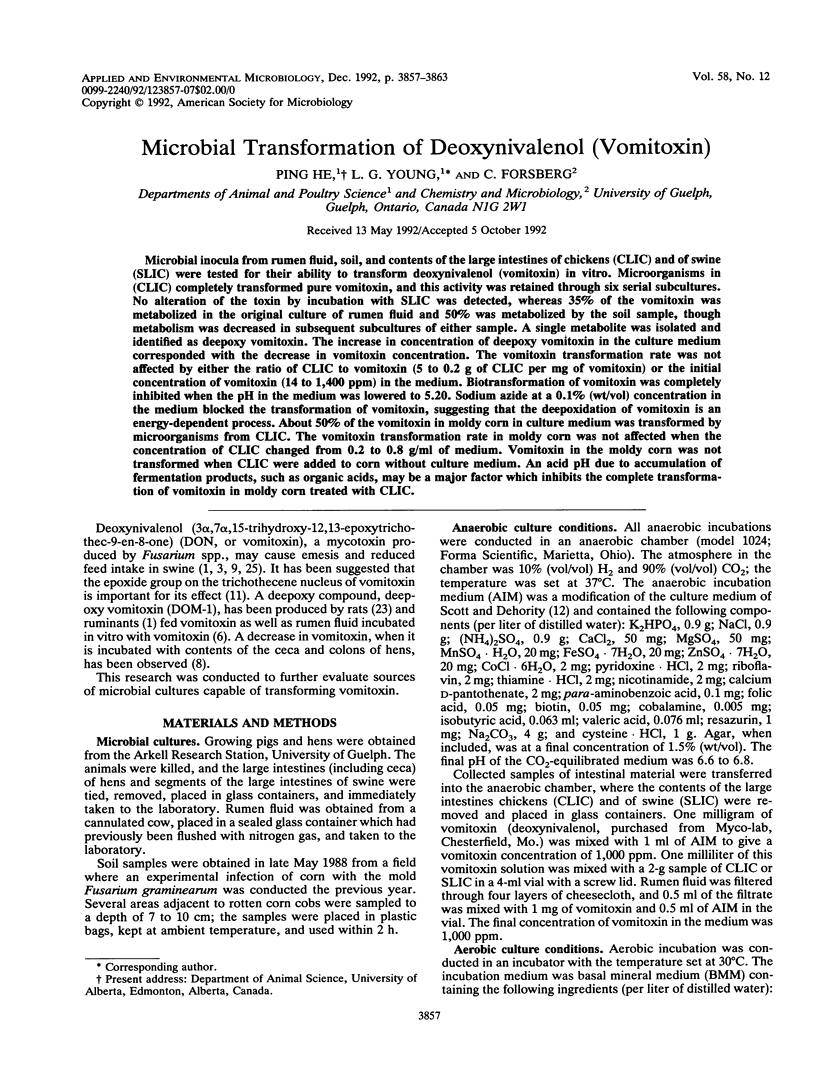
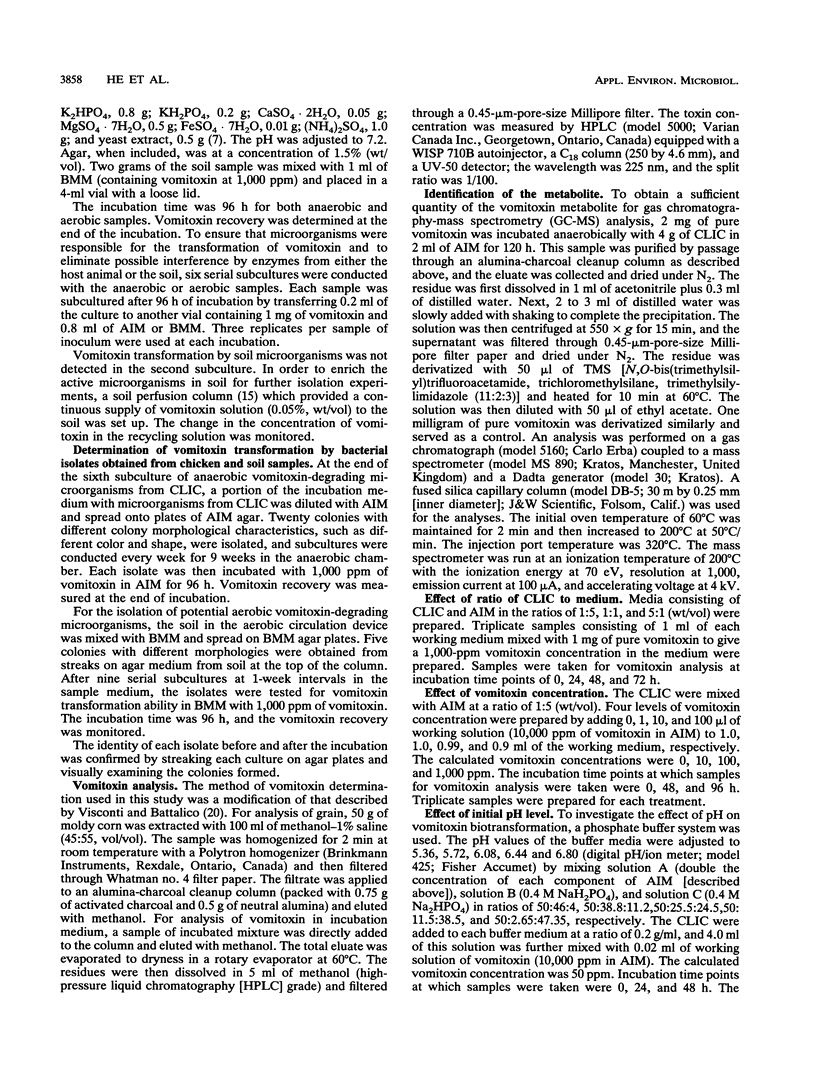
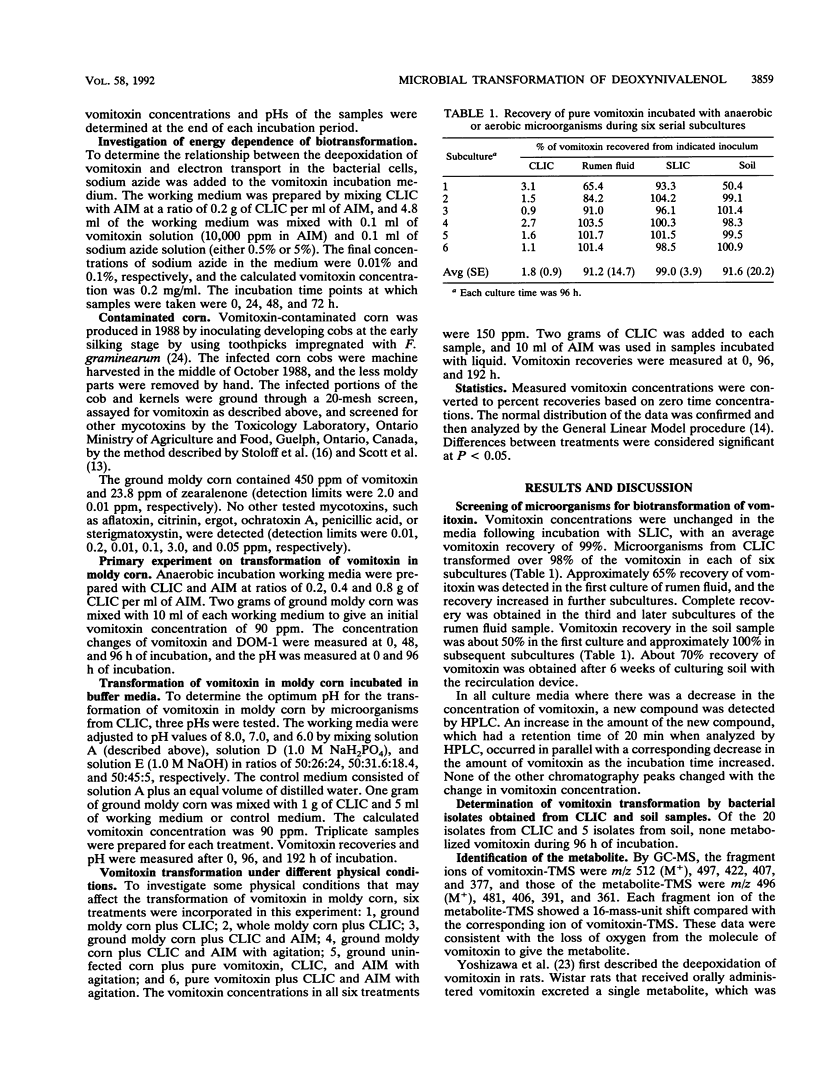
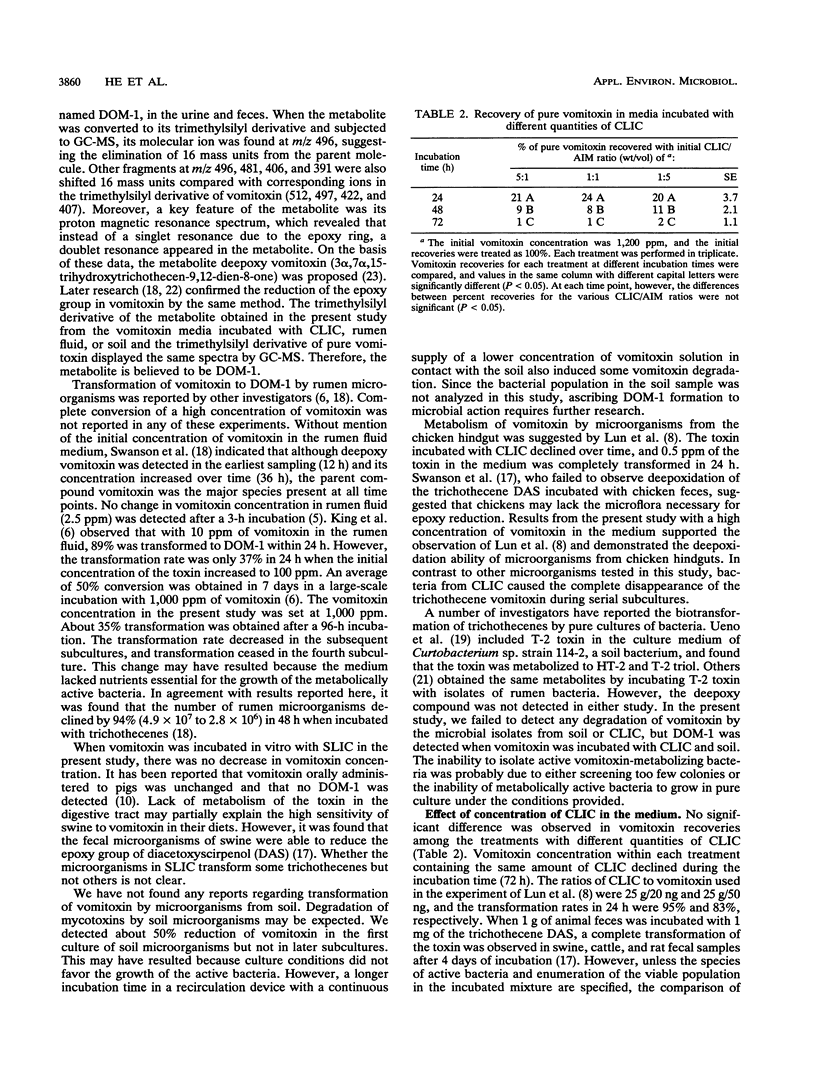

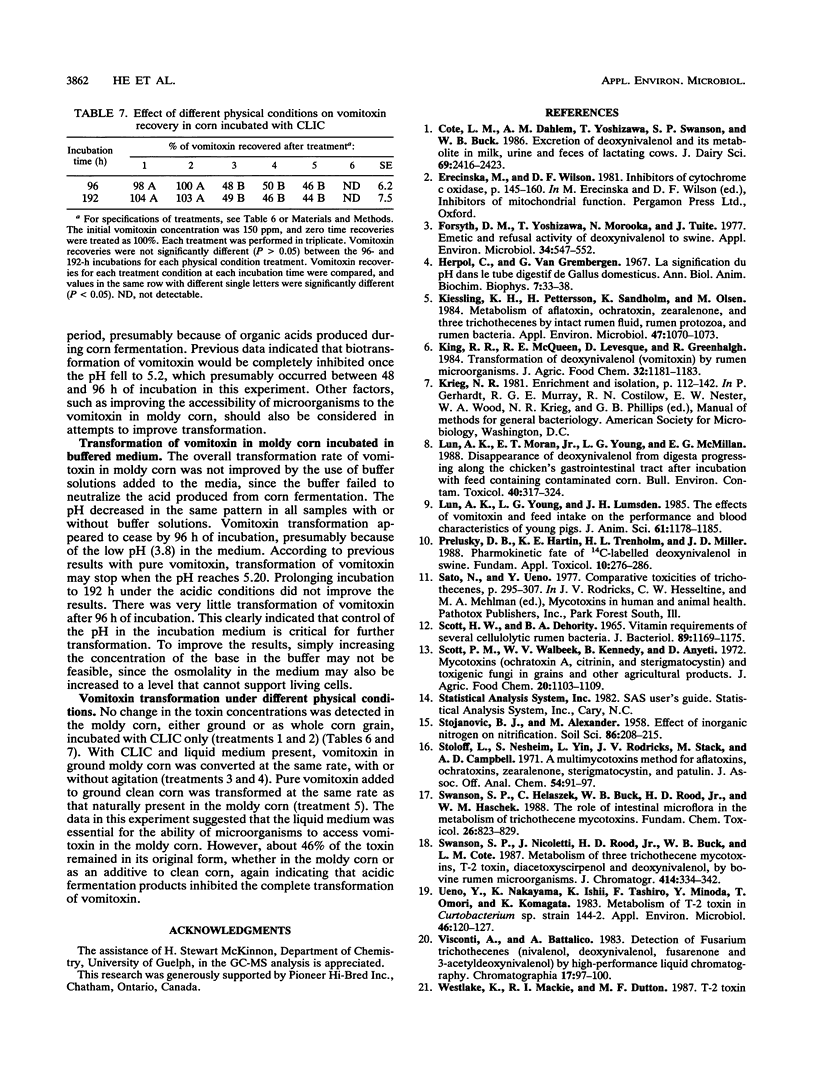
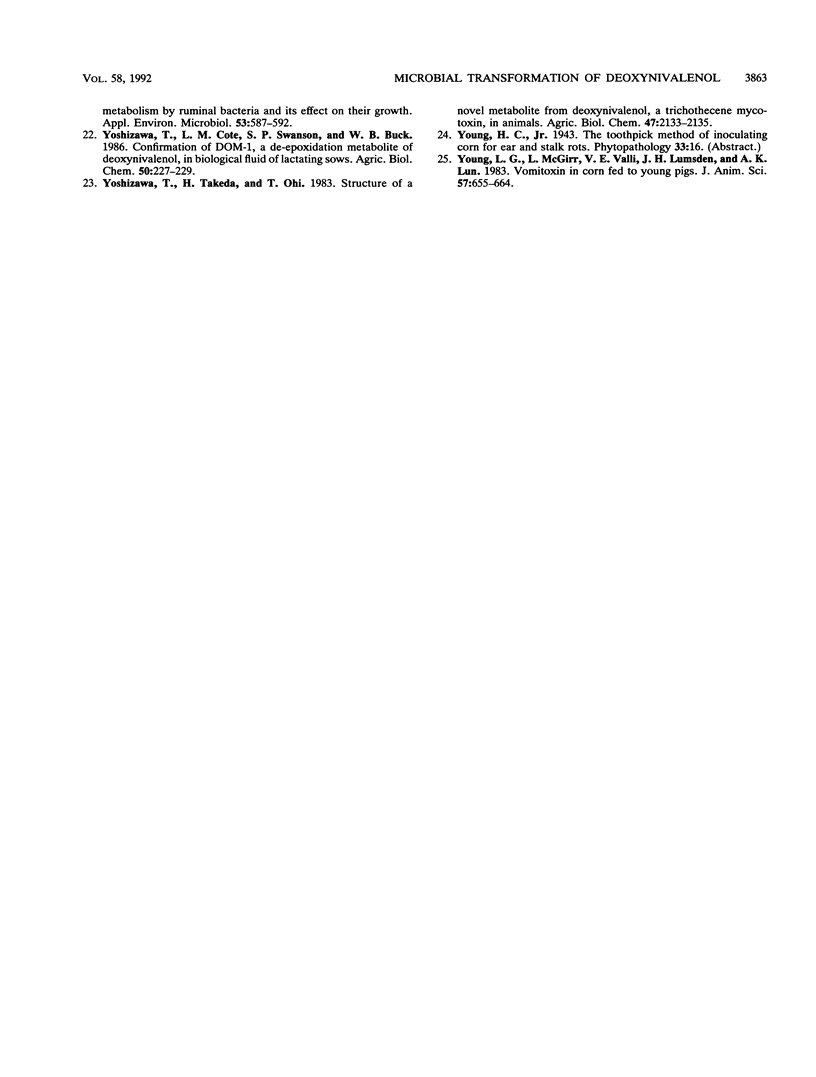
Selected References
These references are in PubMed. This may not be the complete list of references from this article.
- Côté L. M., Dahlem A. M., Yoshizawa T., Swanson S. P., Buck W. B. Excretion of deoxynivalenol and its metabolite in milk, urine, and feces of lactating dairy cows. J Dairy Sci. 1986 Sep;69(9):2416–2423. doi: 10.3168/jds.S0022-0302(86)80681-6. [DOI] [PubMed] [Google Scholar]
- Forsyth D. M., Yoshizawa T., Morooka N., Tuite J. Emetic and refusal activity of deoxynivalenol to swine. Appl Environ Microbiol. 1977 Nov;34(5):547–552. doi: 10.1128/aem.34.5.547-552.1977. [DOI] [PMC free article] [PubMed] [Google Scholar]
- Kiessling K. H., Pettersson H., Sandholm K., Olsen M. Metabolism of aflatoxin, ochratoxin, zearalenone, and three trichothecenes by intact rumen fluid, rumen protozoa, and rumen bacteria. Appl Environ Microbiol. 1984 May;47(5):1070–1073. doi: 10.1128/aem.47.5.1070-1073.1984. [DOI] [PMC free article] [PubMed] [Google Scholar]
- Lun A. K., Moran E. T., Jr, Young L. G., McMillan E. G. Disappearance of deoxynivalenol from digesta progressing along the chicken's gastrointestinal tract after intubation with feed containing contaminated corn. Bull Environ Contam Toxicol. 1988 Mar;40(3):317–324. doi: 10.1007/BF01689086. [DOI] [PubMed] [Google Scholar]
- Lun A. K., Young L. G., Lumsden J. H. The effects of vomitoxin and feed intake on the performance and blood characteristics of young pigs. J Anim Sci. 1985 Nov;61(5):1178–1185. doi: 10.2527/jas1985.6151178x. [DOI] [PubMed] [Google Scholar]
- Prelusky D. B., Hartin K. E., Trenholm H. L., Miller J. D. Pharmacokinetic fate of 14C-labeled deoxynivalenol in swine. Fundam Appl Toxicol. 1988 Feb;10(2):276–286. doi: 10.1016/0272-0590(88)90312-0. [DOI] [PubMed] [Google Scholar]
- SCOTT H. W., DEHORITY B. A. VITAMIN REQUIREMENTS OF SEVERAL CELLULOLYTIC RUMEN BACTERIA. J Bacteriol. 1965 May;89:1169–1175. doi: 10.1128/jb.89.5.1169-1175.1965. [DOI] [PMC free article] [PubMed] [Google Scholar]
- Scott P. M., Van Walbeek W., Kennedy B., Anyeti D. Mycotoxins (ochratoxin A, citrinin, and sterigmatocystin) and toxigenic fungi in grains and other agricultural products. J Agric Food Chem. 1972 Nov-Dec;20(6):1103–1109. doi: 10.1021/jf60184a010. [DOI] [PubMed] [Google Scholar]
- Stoloff L., Nesheim S., Yin L., Rodricks J. V., Stack M., Campbell A. D. A multimycotoxin detection method for aflatoxins, ochratoxins, zearalenone, sterigmatocystin, and patulin. J Assoc Off Anal Chem. 1971 Jan;54(1):91–97. [PubMed] [Google Scholar]
- Swanson S. P., Helaszek C., Buck W. B., Rood H. D., Jr, Haschek W. M. The role of intestinal microflora in the metabolism of trichothecene mycotoxins. Food Chem Toxicol. 1988 Oct;26(10):823–829. doi: 10.1016/0278-6915(88)90021-x. [DOI] [PubMed] [Google Scholar]
- Swanson S. P., Nicoletti J., Rood H. D., Jr, Buck W. B., Cote L. M., Yoshizawa T. Metabolism of three trichothecene mycotoxins, T-2 toxin, diacetoxyscirpenol and deoxynivalenol, by bovine rumen microorganisms. J Chromatogr. 1987 Mar 6;414(2):335–342. doi: 10.1016/0378-4347(87)80058-0. [DOI] [PubMed] [Google Scholar]
- Ueno Y., Nakayama K., Ishii K., Tashiro F., Minoda Y., Omori T., Komagata K. Metabolism of T-2 toxin in Curtobacterium sp. strain 114-2. Appl Environ Microbiol. 1983 Jul;46(1):120–127. doi: 10.1128/aem.46.1.120-127.1983. [DOI] [PMC free article] [PubMed] [Google Scholar]
- Westlake K., Mackie R. I., Dutton M. F. T-2 toxin metabolism by ruminal bacteria and its effect on their growth. Appl Environ Microbiol. 1987 Mar;53(3):587–592. doi: 10.1128/aem.53.3.587-592.1987. [DOI] [PMC free article] [PubMed] [Google Scholar]
- Young L. G., McGirr L., Valli V. E., Lumsden J. H., Lun A. Vomitoxin in corn fed to young pigs. J Anim Sci. 1983 Sep;57(3):655–664. doi: 10.2527/jas1983.573655x. [DOI] [PubMed] [Google Scholar]


